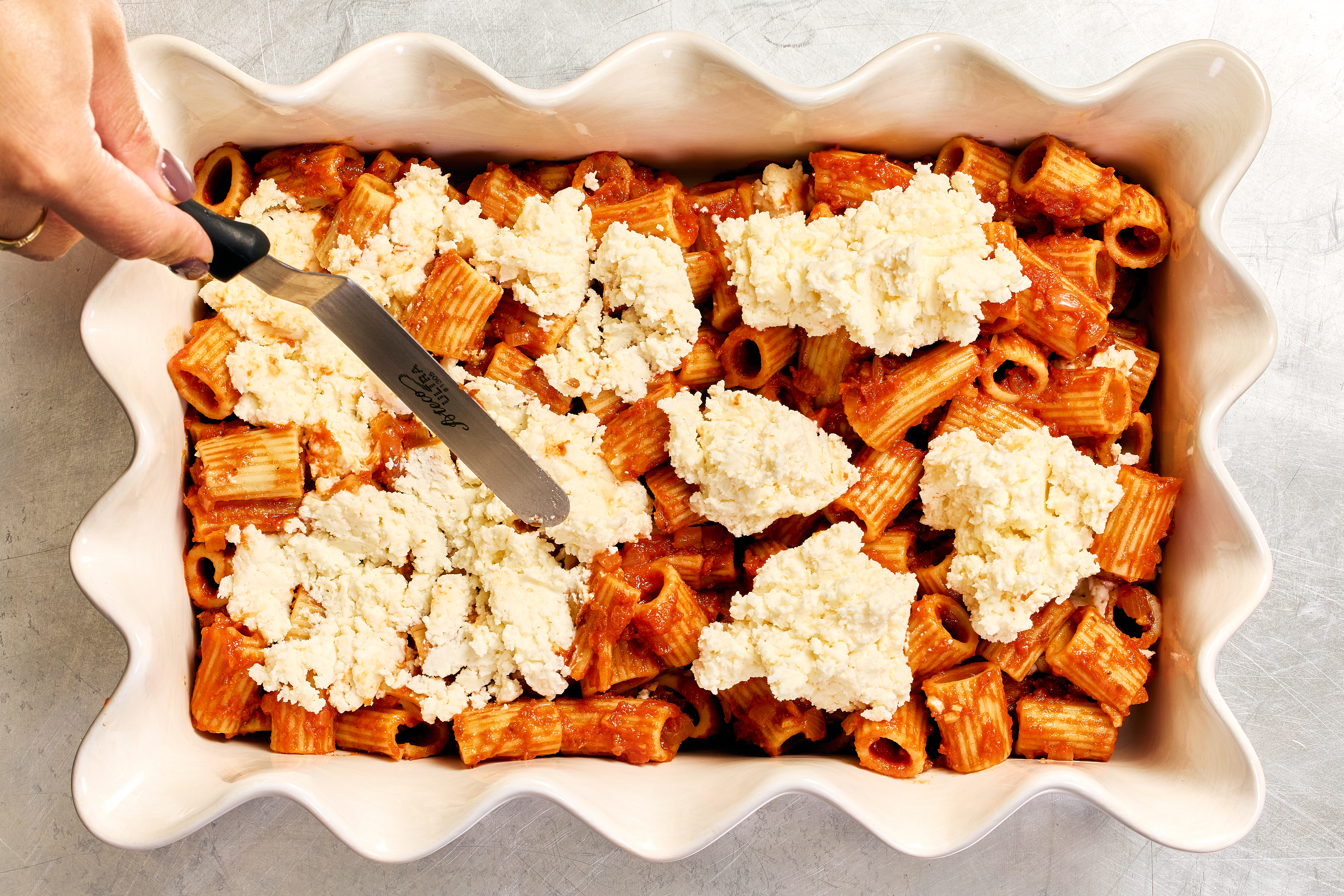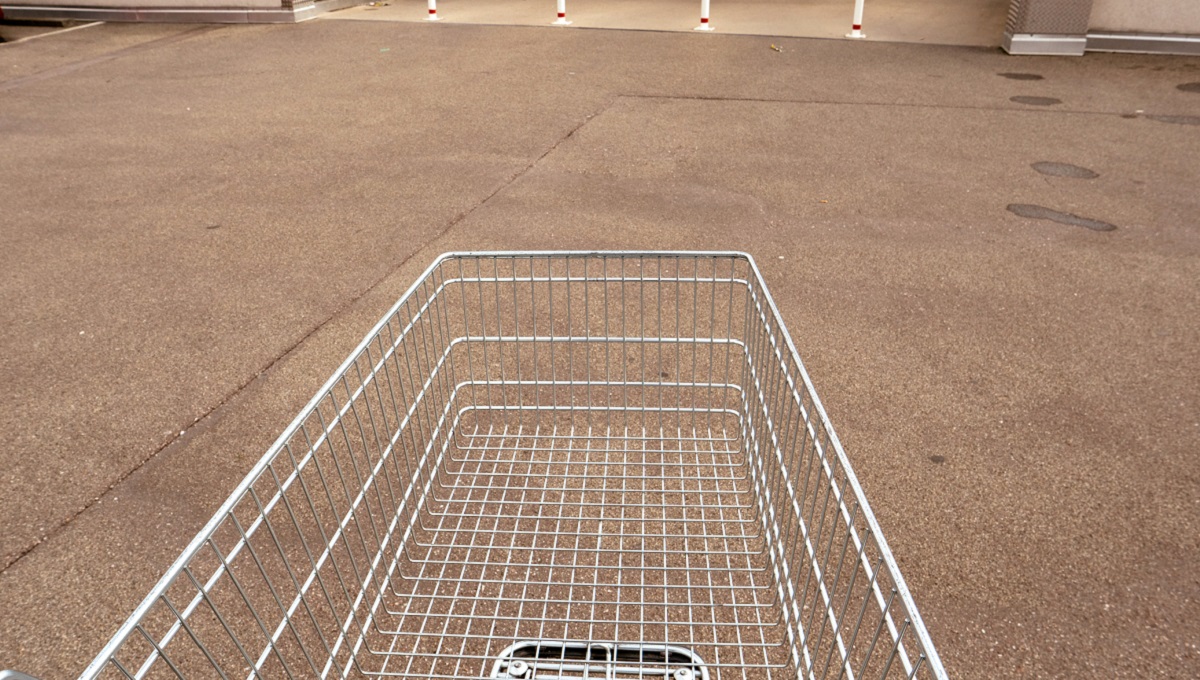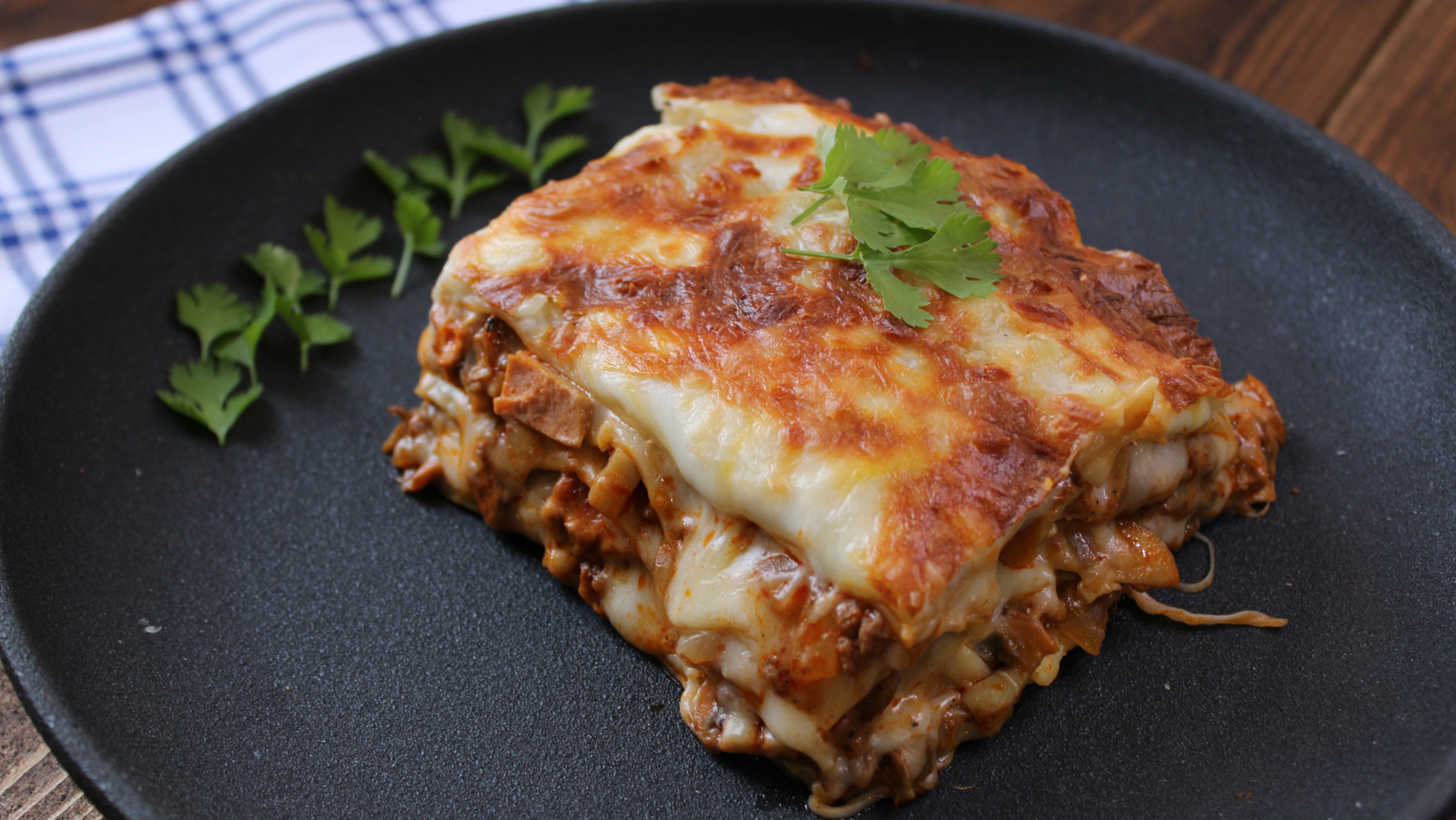
Baked Ziti (with Rigatoni). Justin Tsucalas/photos; Marie Ostrosky/food styling, for The Washington Post Much like the Santa Claus impersonator in my favorite Christmas movie, “Elf,” baked ziti has been sitting “on a throne of lies.” Though it sparkles with the magic and allure of a comforting pasta bake, it makes a lot of promises it doesn’t keep.
And while it has the potential to be sublime, it’s often underwhelming, featuring overcooked, gummy noodles and grainy, soupy sauce. But its popularity online means that the name clearly has some kind of cachet. Ziti is a medium tubular pasta with a smooth outside and traces its roots to the Campania and Sicily regions of Italy.

While baked pasta dishes in Italy date back centuries, baked ziti is part of the Italian American culinary canon and features the titular noodle in a flavorful tomato sauce, with plenty of shredded cheese for heft, flavor and that photogenic melty pull. A few months ago, I decided that I wanted a go-to baked ziti recipe that was going to be consistently good and praiseworthy. I tried a bunch of recipes, and none blew me away.
I wanted sublime results, the kind that make you go and get seconds against your better judgment. As I often do, I went down a rabbit hole that forced my family to eat multiple mediocre results all in the name of recipe testing. In my numerous attempts to reach my platonic ideal, I arrived at some unexpected conclusions.
First, the best baked ziti isn’t made with ziti but with a short, tubular ridged pasta such as rigatoni. While you noodle on that, allow me to explain. While ziti’s wide “tunnels” are effective at capturing bits of sauce for a hearty bake, the pasta’s smooth exterior makes it less than ideal for crisping on the outside.
What ziti sorely lacks is texture. Mezzi rigatoni or regular rigatoni, on the other hand, offer plenty of ridges that get crispy when blasted with heat. (You can also use other short, tubular pasta with ridges, such as penne or cavatappi.
) I wanted to maximize the crispy bits, so each portion could resemble those corner pieces of lasagna everyone fights over. “More crispy, more better,” noted a colleague tasting the dish at our photo shoot. My other point of contention is the often watery, grainy sauce that typically features ricotta cheese and fresh mozzarella.
The former doesn’t play nicely with acidic ingredients: Even when whipped in the food processor with heavy cream — a trick that supposedly helps it remain creamy while baking — the mixture turns grainy and releases too much liquid. The latter also exudes a lot of liquid and results in a sauce that’s more soupy than saucy. After much trial and error, I remembered once making a lasagna and relying on crème fraîche for that luscious, creamy element.
Since it doesn’t break when combined with acid-rich foods such as tomato sauce, you get the desired texture and tang to complement the sauce without the unappetizing appearance. Using low-moisture mozzarella, instead of fresh, reduced the likelihood of a watery sauce and improved the odds of the coveted cheese pull. I also wanted a marinara sauce with deep umami, so in addition to the aromatics such as onion, garlic and basil, I added a generous dollop of double-concentrated tomato paste, which I caramelized slightly in the oil for even more depth.
I then let the sauce simmer to further concentrate its flavors and added a pinch of sugar to balance everything out. (Depending on the brand of tomatoes you use, you may not need sugar at all. And, if you’re in a rush, just use your favorite store-bought marinara sauce.
) Once the pasta is done baking, it’s important to let it sit for at least 10 minutes before you serve it. Not only is the inside of the pasta scaldingly hot, but also the individual portions will hold their shape better if you let the bake settle a bit. So, while I’m (not) sorry for the bait and switch of my baked (not) ziti, I am unapologetic for the delicious results you’ll get if you trust me on this.
I made my poor family eat so many different iterations, they begged for a break, but once they tasted the final version, they actually clapped at the table — and then went back for seconds. Spreading dollops of the cheese mixture for Baked Ziti. Justin Tsucalas/photos; Marie Ostrosky/food styling, for The Washington Post Baked Ziti (with Rigatoni) This crowd-pleasing baked ziti is actually made with rigatoni, and strikes the right balance between cheesy and saucy.
To ensure the finished recipe doesn’t wind up soupy or grainy, assistant recipes editor Olga Massov prefers crème fraîche in place of more traditional ricotta, and low-moisture, whole-milk mozzarella cheese instead of fresh. While ziti is the traditional pasta shape here, Massov’s preferred pasta is mezzi rigatoni, which boasts more pronounced ridges and results in a dish that’s full of delightfully crispy bits, much like the corners of lasagna that everyone fights over. This pasta bake is great with a simple green salad, particularly baby arugula lightly dressed with lemon juice, olive oil, salt and pepper.
For a more weeknight-friendly version, see Variations. Servings: 6-8 Active time: 50 minutes. Total time: 1 hour 35 mins, including cooling time Substitutions: Crème fraîche >> sour cream.
(It might curdle, but will still taste good.) Yellow onion >> white onion. Parmesan >> grana Padano or pecorino Romano.
Mozzarella >> Muenster or other similar melty cheese. Rigatoni >> ziti, cavatappi or other short, tubular pasta shape. Variations: To make this dish more weeknight-friendly, instead of making the tomato sauce and grating/shredding cheese by hand, use 3 1/2 cups store-bought marinara and pre-grated/pre-shredded cheese.
Make ahead: The dish can be assembled, covered tightly and refrigerated for up to 1 day or frozen for up to 2 months. Defrost completely in the refrigerator, then place in an oven, set it to 400 degrees and, once the oven signals it has reached the desired temperature, bake for 30 to 35 minutes, or until the pasta is generously burnished and bubbling in spots. Storage: Refrigerate for up to 4 days.
Reheat in a 350-degree oven until warmed through. INGREDIENTS For the tomato sauce: 2 tablespoons olive oil 1 tablespoon unsalted butter 1 medium yellow onion (8 ounces), finely chopped Fine salt Freshly ground black pepper 4 garlic cloves, minced or finely grated 2 tablespoons tomato paste, preferably double-concentrated One (28-ounce) can crushed tomatoes 1/4 cup water 2 fresh basil sprigs 1 teaspoon crushed red pepper flakes, plus more as needed (optional) Granulated sugar (optional) For the dish: One (8-ounce) container crème fraîche (see Substitutions) 8 ounces low-moisture, whole-milk mozzarella cheese, coarsely grated, divided 1 cup (3 1/2 ounces) finely grated Parmesan cheese, plus more as needed, divided Pinch freshly grated nutmeg Fine salt Freshly ground black pepper Milk (any fat level), as needed (optional) 1 pound dried regular or mezzi rigatoni, penne or other short, tubular pasta DIRECTIONS Position a rack in the middle of the oven and preheat to 400 degrees. Have ready a large sheet pan and a 3-quart or 8-by-11-by-3-inch ovenproof baking dish.
Set a large pot of water over high heat and cover with a lid. If it comes to a boil before you’re ready to cook the pasta, decrease the heat to the lowest level and keep the pot covered. Make the tomato sauce: In a large, heavy-bottomed pot over medium heat, heat the oil until shimmering and melt the butter.
Add the onion, season lightly with salt and black pepper, and cook, stirring occasionally, until softened and translucent, about 8 minutes. Adjust the heat as needed to prevent the onion from browning; you want it to really soften. Stir in the garlic and cook, stirring frequently, until fragrant, about 1 minute.
If you had decreased the heat earlier, return it back to medium, add the tomato paste and cook, stirring frequently, until it darkens, about 2 minutes. Add the crushed tomatoes and stir to combine. Add the water to the now-empty can and swirl it around to get all of the remaining tomato bits.
Add that water to the tomato mixture and stir to combine. Add the basil sprigs and crushed red pepper flakes, if using, stir to combine, then season to taste with salt and black pepper. Bring the sauce to a gentle simmer and cook, stirring occasionally and adjusting the heat as needed to prevent scorching on the bottom and to maintain a gentle simmer, until the sauce thickens and the flavors meld, 20 to 30 minutes.
(Different brands of crushed tomatoes have different levels of wateriness.) Taste, and add a generous pinch or two of sugar, if desired, to give the sauce fullness and take off any aggressive acidity. Discard the basil sprigs.
Make the dish: While the sauce is simmering, in a medium bowl, stir together the crème fraîche, half of the mozzarella, 2/3 cup (generous 2 1/4 ounces) of the Parmesan and the nutmeg until well combined. Season to taste with salt and pepper. If the mixture is too thick and not easily spreadable, add milk, 1 tablespoon at a time, until you get the desired consistency.
When the water comes to a boil, add enough salt so it tastes mildly salty. (The sauce and the crème fraîche mixture will also add saltiness.) Add the pasta and cook for 2 minutes less than the package instructions indicate for al dente — you want the pasta to still have a bit of firmness when you bite into it.
(It will continue to cook in the oven, so it’s important to not overcook it now.) Drain the pasta. Once the tomato sauce is done, transfer the cooked pasta to the sauce and stir to combine, ensuring that the insides of the noodles are coated.
Spread one-third of the pasta mixture in an even layer in the prepared dish. Dollop half of the crème fraîche mixture over the pasta, and use a small spoon or offset spatula to spread it in as even a layer as possible; it’s OK if it’s not perfect. Continue with another one-third of the pasta mixture, followed by the remaining crème fraîche mixture.
Top with the remaining pasta, followed by the remaining mozzarella and all but 1 tablespoon of the Parmesan. Set the baking dish over the prepared sheet pan and transfer to the oven. Bake for about 30 minutes, or until the pasta is generously burnished and the sauce is bubbling in spots.
Sprinkle the remaining 1 tablespoon of Parmesan over the pasta and let sit for at least 15 minutes before serving. Nutritional information: 413 calories, 24 g fat, 13 g saturated fat, 34 g carbohydrates, 537 mg sodium, 37 mg cholesterol, 16 g protein, 3 g fiber, 8 g sugar. We believe it’s important to offer commenting on certain stories as a benefit to our readers.
At its best, our comments sections can be a productive platform for readers to engage with our journalism, offer thoughts on coverage and issues, and drive conversation in a respectful, solutions-based way. It’s a form of open discourse that can be useful to our community, public officials, journalists and others. Read more.
.. We do not enable comments on everything — exceptions include most crime stories, and coverage involving personal tragedy or sensitive issues that invite personal attacks instead of thoughtful discussion.
For those stories that we do enable discussion, our system may hold up comments pending the approval of a moderator for several reasons, including possible violation of our guidelines. As the Maine Trust’s digital team reviews these comments, we ask for patience. Comments are managed by our staff during regular business hours Monday through Friday and limited hours on Saturday and Sunday.
Comments held for moderation outside of those hours may take longer to approve. By joining the conversation, you are agreeing to our commenting policy and terms of use . More information is found on our FAQs .
You can modify your screen name here . Show less Please sign into your Press Herald account to participate in conversations below. If you do not have an account, you can register or subscribe .
Questions? Please see our FAQs . Your commenting screen name has been updated. Send questions/comments to the editors.
« Previous Next ».














